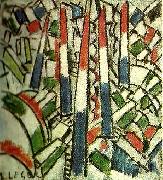Wholesale Oil Painting No Minimum |
|||||||||||
|
|
|||||||||||

|
|||||||||||
|
|
|
||||||||
Fernand LegerFrench Cubist Painter, 1881-1955,was a French painter, sculptor, and filmmaker,Leger was born in the Argentan, Orne, Basse-Normandie, where his father raised cattle. Fernand Leger initially trained as an architect from 1897-1899 before moving in 1900 to Paris, where he supported himself as an architectural draftsman. After military service in Versailles in 1902-1903, he enrolled at the School of Decorative Arts; he also applied to the Ecole des Beaux-Arts but was rejected. He nevertheless attended the Beaux-Arts as a non-enrolled student, spending what he described as "three empty and useless years" studying with Gerome and others, while also studying at the Academie Julian. He began to work seriously as a painter only at the age of 25. At this point his work showed the influence of Impressionism, as seen in Le Jardin de ma mere (My Mother's Garden) of 1905, one of the few paintings from this period that he did not later destroy. A new emphasis on drawing and geometry appeared in Leger's work after he saw the Cezanne retrospective at the Salon d'Automne in 1907. In 1909 he moved to Montparnasse and met such leaders of the avant-garde as Archipenko, Lipchitz, Chagall, and Robert Delaunay. His major painting of this period is Nudes in the Forest (1909-10), in which Leger displayed a personal form of Cubism??his critics called it "Tubism" for its emphasis on cylindrical formsethat made no use of the collage technique pioneered by Braque and Picasso. In 1910 he joined with several other artists, including Delaunay, Jacques Villon, Henri Le Fauconnier, Albert Gleizes, Francis Picabia, and Marie Laurencin to form an offshoot of the Cubist movement, the Puteaux Group??also called the Section d'Or (The Golden Section). Leger was influenced during this time by Italian Futurism, and his paintings, from then until 1914, became increasingly abstract. Their vocabulary of tubular, conical, and cubed forms are laconically rendered in rough patches of primary colours plus green, black and white, as seen in the series of paintings with the title Contrasting Forms. Leger's experiences in World War I had a significant effect on his work. Mobilized in August 1914 for service in the French Army, he spent two years at the front in Argonne. He produced many sketches of artillery pieces, airplanes, and fellow soldiers while in the trenches, and painted Soldier with a Pipe (1916) while on furlough. In September 1916 he almost died after a mustard gas attack by the German troops at Verdun. |
||||||||
|
|
||||||||
fjortonde juli
fjortonde juli Painting ID:: 67908 |
1914
se 1914 se |
|||||||
|
CONTACT US |

